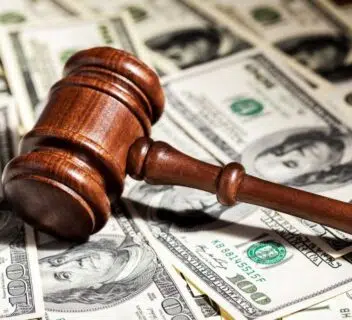Rear Ended in an Accident? Compensation Could Be Available
If you’ve been rear-ended, you might have suffered injuries and other losses that you don’t entirely know how to handle — for example, you may not know whether you have a legal claim that’s worth paying attention to or pursuing. We encourage you to get in touch with an experienced accident lawyer for an evaluation of your rear-end collision case and for guidance on your strategic options for recovery.
When a rear-end crash occurs, it often involves a driver hitting another vehicle from behind, potentially leading to a chain reaction or pileup accident. This can complicate legal disputes due to the multiple parties involved and the determination of fault.
That being said, if you’d like to understand the basic legal issues common to many rear-end disputes, read on to learn more!
Rear-end collisions and fault
Fault in a rear-end car accident is — at the basic level — rather straightforward when it comes to establishing fault and liability, especially in most rear-end collisions. Unless you were not legally stopped at a traffic light, for example, there’s not much you can do if someone suddenly rams into the back of your car. The fault doesn’t get assigned to you in that type of car accident.
This can be very helpful, because even though partial fault doesn’t necessarily prevent you from suing and being compensated, it may reduce your overall compensation amount. So if your accident is one of the more straightforward rear-end crashes is straightforward (i.e., the defendant is fully at fault), then you have a significant advantage in the litigation process. While fault is often clear in these cases, the trailing driver is typically found at fault unless exceptional circumstances apply.
Suing multiple defendants may be possible
A rear-end car accident may involve multiple defendants beyond the at-fault driver. This can allow you to sue those who have “deeper pockets” and better insurance coverage, thus maximizing your potential compensation.
Rear-end accidents may include defendants such as:
- The other driver, especially if their negligence or actions contributed directly to the accident. It’s crucial to gather information from the other driver, determine their level of negligence, and address any shared fault scenarios.
- Other drivers who contributed to the accident (i.e., a swerving driver who forced another driver to move into your lane, thus rear-ending you).
- The employer of the driver who rear-ended you.
- The auto manufacturer (for example, they may have defectively manufactured the brake system that failed, leading to a rear-end crash).
- The repair shop (if they failed to adequately inspect and correct the failing brake system).
- The City
- Other property owners
- And more
Injuries in rear-end collisions
Rear-end collisions are rather unique concerning their dangers (and the resultant consequences for the injury victims). Generally speaking, injuries from the rear (caused by a collision from the rear driver) tend to be less immediately severe, or obvious.
There are four main reasons for that:
- Rear-end collisions often occur at low or medium speeds. As such, the initial impact force tends to be less.
- Rear-end collisions often occur when one vehicle is stopped. This also reduces the initial impact force as compared to head-on collisions, which are additive and therefore significantly more dangerous.
- When your vehicle is rear-ended — if it’s in dense traffic or you’re at a stop — it’s very likely that you will hit the vehicle in front of you, thus limiting where your vehicle can be pushed. This can prevent the accident from spiraling out of control.
- Vehicle “rear ends” often have crumpling space, so much of the force of impact can be absorbed by the crumpling of the trunk area.
That being said, if you’ve been involved in a rear-end accident and your injuries seem minor or even nonexistent on the surface, that doesn’t mean that there’s nothing major going on below the surface.
For example, whiplash injuries are rather serious injuries, common in the rear-end accident context. Whiplash injuries can lead to the exacerbation of degenerative conditions, like spinal issues. These symptoms may only appear years later. That’s why it’s so important to consult an attorney who can help you work with medical experts to identify all aspects of your injury, both short and long-term.
Damages in rear-end accident lawsuits
In rear-end accident lawsuits, damages can vary quite significantly. Damages measure the losses sustained by the injury victim. Claimable losses may include, but are not necessarily limited to:
- Wage loss
- Loss of earning capacity
- Medical expenses
- Property loss
- Pain and suffering
- Loss of enjoyment of life
- Loss of companionship
- And more
Even under the same circumstances, two different crash victims can experience very different losses.
For example, let’s take two rear-end collision scenarios (A and B). In Scenario A, the front vehicle injury victim is unemployed at the time of the rear vehicle accident. Their wage loss damages would effectively be zero. By contrast, in Scenario B, the injury victim is a construction worker with a $60,000 per year income. Due to their injuries, they cannot work for a year. Their wage loss damages would be around $60,000.
Thus, even though the collision itself is the same, these two plaintiffs have unique claimable losses to recover compensation.
Given the range of possibilities, you’ll want to work with an experienced injury lawyer who knows how to maximize your damages claim and develop a persuasive supportive argument on your behalf.
What are some things you should do if you are involved in a collision?
After a collision, here are some notable things you should do to ensure that you’re in the best possible position to be compensated through an eventual settlement, insurance claim payout or court award:
- Seek emergency medical attention if necessary. If your injuries are severe and require immediate attention, don’t delay in doing so — the defendant may attempt to argue that your injuries were caused (or exacerbated) by the delay in seeking medical attention.
- Take photos and videos of the accident scene, if possible. Assuming you do not need emergency medical attention, use your phone to record photos and videos of the accident scene — this can be used as valuable evidence to support your claims later.
- Check and document the condition of the other vehicle’s brake lights. The driver’s brake lights are crucial for establishing negligence, especially if they were not in working order at the time of the accident.
- Obtain contact information of the defendant and eyewitnesses. This will help your attorney to connect to witnesses who can provide supportive testimony that could spell the difference between a win or a loss.
- Avoid speaking to an insurance company until you have consulted an attorney about what you should and should not say. Insurers will do everything they can to get you to disclose information that could be used to undermine your claims — that lets them reject your claim or lowball you.
- Consult an attorney as soon as possible. Attorneys have many roles, and that includes gathering and preserving evidence, as well as communicating on your behalf with law enforcement, defendants, witnesses, insurers, and others. They are a valuable resource at every stage of the legal process.
Don’t delay! Understanding statute of limitations deadlines
The statute of limitations varies from state to state, but — essentially — it is a deadline that applies to your legal claim. If you do not file your claim promptly (i.e. before the deadline passes), then the courts will dismiss your claim should you attempt to bring it at a later time.
In other words: if you wait too long, you won’t have enough space to seek financial compensation under the law.
For example, in California, the statute of limitations for a negligence-based car accident is two years from the date of injury. If you fail to bring your claim before the two-year deadline passes, then you’ll be barred from suing and recovering through the litigation process. This effectively prevents you from being compensated.
Some exceptions do apply, however, so be sure to consult an accident attorney for guidance on how best to proceed with a claim that is “past” the deadline.
Contact 1-800-THE-LAW2 for a Free Legal Consultation
If you’ve been rear-ended in an accident, then you may be entitled to sue for compensation to cover your injuries and other losses. However, as the injury victim, you may be feeling overwhelmed. After all, your focus may be on recovering and rehabilitating from your injuries after the accident — managing the legal issues can be a burden that you aren’t equipped to deal with. That’s why it’s important to work with a personal injury lawyer who can handle the dispute on your behalf.
Contact 1-800-THE-LAW2 for a free initial consultation with an experienced attorney in our legal network. During this initial consultation, you’ll have the opportunity to discuss your case in more detail and get guidance on how best to proceed with your case (from a strategic perspective).
If you decide against moving forward, that’s ok! There’s no obligation to work with the attorney who provided the free consultation. So, what are you waiting for? Call in today to get started with the legal process.
We look forward to assisting you.




